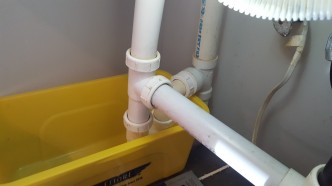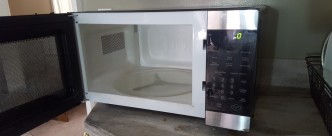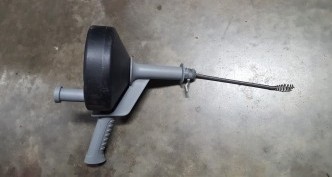 ut there on that shining beacon of truth called the Internet
there are dozens of sites discussing vinegar and baking
soda (sodium bicarbonate) for clearing drain clogs. Half of
them say they work and half say they're useless. What's the
truth? Are they safe for your pipes?
ut there on that shining beacon of truth called the Internet
there are dozens of sites discussing vinegar and baking
soda (sodium bicarbonate) for clearing drain clogs. Half of
them say they work and half say they're useless. What's the
truth? Are they safe for your pipes?
As a biochemist, I've worked with chemicals and biomolecules and dealt with clumps of dirt and clogs for my entire career. If you think unclogging a drain is tough, try unclogging tiny pieces of stainless steel lab tubing that are clogged with unknown debris. We have to use chemicals which would dissolve not just the tubing in your house, but probably you as well.
In this article I will describe the chemistry of clogs, surface dirt, and cleaning agents and tell you what does and doesn't work. This might seem trivial, but the chemistry of dirt is a fascinating topic.

PVC sink trap and bucket. On this one, the U-shaped trap can be removed without tools. Once the drain is fixed, it's time to fix the code violation on the electric wiring left by the previous owner
Kitchen sink clogs
Let's get this out of the way first: praying doesn't work. The best praying can do is to ask for divine intervention to get the plumber to answer his phone and maybe get him to show up in a week or so. The phone company's policy of allowing phone spam is killing the plumbing business dead.
I'm assuming your pipes are Schedule 40 PVC, which is the most common in residences. If you have metal pipes, none of the below is applicable.
How you unclog a sink depends on where the clog is. If the clog is in the sink trap, as the old Drano and Liquid Plumber commercials portrayed it, almost anything will work. But in that case it's much easier just to unscrew the PVC sink trap, take it out, and clean it with a brush.
If it's not, everything depends on whether you can get the chemicals to the clog. They might have to travel through several feet of standing water, which is one reason drain cleaners are made heavier than water. However, if there's a segment of pipe that's almost horizontal, even this doesn't work and the only solution is usually to snake the drain. In all the times I had a clog, snaking is the only thing that worked reliably.
Vinegar and baking soda
Vinegar is 5% acetic acid. Acetic acid is a weak acid, which means it's only partly ionized. What does this mean?
If the clog is above the sink trap, it can be easily removed using a plastic Zip-It drain cleaner or even a bent wire with a hook on the end. This only works if the clog is mostly hair or solid debris.
If the clog is in the sink trap, it can sometimes be disloged by creating turbulence. Attach a piece of tubing to a small air pump, push it to the clog, and turn on the pump. Or use a commercial drain cleaner, or the vinegar-baking soda trick. Don't allow pressure to build up inside the pipe.
If it's beyond the trap, you usually need to snake it.
Never pour boiling water or use a plunger on a drain pipe.
Clogs are boring, but the chemistry of dirt is fascinating.
The pH of a solution is determined by the acid ionization constant, or pKa. The pKa of the acetate ⇌ acetic acid equilibrium is 4.8, which means only a tiny amount of H+ (free acid) is present. When you mix it with sodium bicarbonate (the pKa of the carbonic acid ⇌ bicarbonate equilibrium is 6.35), you're making acetate-bicarbonate buffer, a mixture of sodium acetate, sodium bicarbonate, and acetic acid. Depending on the exact ratio, your final mixture might be slightly acidic, neutral, or even slightly basic. But because it's a mixture of two pH buffers, it's likely to be somewhere between 3.6 and 5.6, which is about the same acidity as coffee.
Some molecules, like phosphate and carbonate, have several different pKa values—one for each ionizable atom. For instance, with carbonate there are two ionization steps, so you always have an equilibrium of carbonic acid (H2CO3) ⇌ bicarbonate (HCO3−) ⇌ carbonate (CO32−). Carbonic acid can lose a water molecule (H2O), giving carbon dioxide (CO2). Biomol.net has a buffer calculator for simple buffers if you're interested. The pH of mixtures of different buffers takes more arithmetic, but it can be calculated accurately. Nobody ever does this; it's much easier just to measure it.
How it works
Highly polar compounds like sodium acetate will hydrate the molecules in the clog, mainly by increasing their ionization and by exchanging any calcium ions with sodium. This weakens the clog and makes it ‘fluffier,’ making it harder for it to stick. The CO2 might help by creating turbulence. If so, then bubbling air into the clog through a piece of tubing should also work. If the clog is deep inside the pipe, the vinegar will be too dilute to do anything and the CO2 will never reach it. But as long as it doesn't get into a closed pipe where it could create pressure, it's mostly harmless.

Kenmore 721-66223 microwave oven purchased in the late 1990s or early 2000s, after cleaning with 30% vinegar. The light burned out several years ago
Microwave ovens
Microwave heating can cause food to splatter all over, and then polymerize it. Put your microwave outside with a dish containing 50 ml of 30% vinegar (from a hardware store) in it. Cook it for 5 minutes, then wait 30 minutes for it to cool down. Wearing rubber gloves, you can now remove the dirt with a paper towel. Then clean any grease with a towel wetted with denatured alcohol. If there are brown burn stains that can't be removed this way, they're permanent. Mask any openings and give it a coating of white enamel spray paint. Unfortunately, spray painting over the dirt doesn't work; you have to clean it off first.
Drain snake

Manual drain snake
If the clog is too far down in the pipe for chemicals, you need a drain snake. A drain snake is a long flexible stainless steel cable in a small plastic drum. Buy the longest one that's available. Put down a tarp and kneeling pad on the floor, wear rubber gloves, and put a bucket under your sink. Pull the cable out and drive it into the pipe starting at a point downstream of the sink trap. Then lock the cable and rotate the drum using the handle. It's essential to move forward and backward when you feel a clog; otherwise it will just punch a small hole in the clog and the drain will clog up again in a few months. This takes a bit of practice, and it's a good reminder of how much skill and knowledge it must take to be a plumber. Don't forget to dry the cable off before winding it back up.
Boiling water is not safe for pipes
Pouring boiling water down the drain might kill some of the algae and bacteria that produce a bad smell. It might even melt some of the low melting fats in a clog. But it is a very bad idea.
Schedule 40 PVC is only rated to 140 degrees F. According to the Charlotte Pipe and Foundry Plastics Technical and Installation Manual , PVC handles only 22% as much pressure at 140°F as it does at 73 degrees (the bursting pressure for 2-inch PVC decreases from 280 psi to 61.6 psi). Fittings are even worse: the working pressure of a PVC fitting is only 60% of that of the tubing.
The weakest point is the joints, where two pieces are stuck together with PVC adhesive. If your builder didn't glue them correctly, there's no telling what would happen.
The bigger the diameter, the less pressure a pipe can take. That's probably why they put such small tubing in your house. It's better to give you a clog than to risk a rupture.
Plungers are not safe for pipes
Using a plunger to transmit hydrostatic pressure to the clog is NOT recommended. It would be as bad as water hammer, which is a banging noise caused by air or by valves that shut off too fast. Water hammer is so harmful that plumbing has to be specially engineered to prevent it. It's especially bad on hot days or after you've poured hot water or heat-producing chemicals like Drano into the drain. If your plumber finds a mess of ruptured drainpipe with caustic chemicals dripping out of it, he or she will likely decline to touch it. Not even God can get him to answer the phone after that.
Is “30% vinegar” safe for pipes?
What about that 30% vinegar (acetic acid solution six times stronger than white vinegar) sold in hardware stores? This stuff is the only thing that eliminates odors in PVC shower drains and kitchen drains. If cleaning your drain with a flexible brush doesn't work, pour a SMALL amount in the drain, cover it up for an hour, then flush with water. In my experience, it does work, unlike Drano, baking soda, Pine-Sol, detergent, or any of the other things I poured in there. Just remember: WEAR RUBBER GLOVES AND DON'T INHALE THE FUMES.
How does it work? My guess is the strong vapors that come off it kill bacteria and whatever else is on the entire inside surface of the pipe, which in many houses runs almost horizontally. Detergent and Drano just lie on the lower inside surface, killing only half the bacteria.
There's no consensus about whether 10% acetic acid (which is about what you'd end up with by pouring it in) harms PVC or not. Standard chemical compatibility charts say yes, manufacturers say no. To learn the truth I soaked a small section of Sched 40 in it overnight. The next day it looked and felt exactly the same. It was no softer, the surface was identical, and even the printing on it was unaffected. You wouldn't store 30% acetic acid for long periods in a PVC container, but occasional small amounts of it seem to be reasonably safe.
Cleaning a glass stovetop
Lots of people hate electric stoves, especially those glass ones. Grease is of course easy to remove with denatured alcohol. But what happens is that heat polymerizes the grease. Fats are composed of fatty acids attached to a glycerol molecule by an ester bond. (There are many other kinds of lipids. It's a fascinating topic but outside the scope of this article.) Proteins and carbohydrates are often mixed in, making the dirt harder to remove. Zero-trans fats may have health benefits, but they're more likely to polymerize. The longer this non-trans-fat oil remains on a surface, the harder it is to clean. In commercial operations, unless periodically cleaned, it's often cheaper to replace the equipment than to spend the effort cleaning it.
Easy Off, which is a formulation of 4–8% sodium hydroxide (a strong base), is sometimes used to clean polymerized grease from metal surfaces. But strong bases attack glass and aluminum, and they are harmful to humans on skin contact. Using any basic substance on glass, such as Bon Ami (calcium carbonate) or Easy Off, will etch it. Abrasives are absolutely forbidden. Even an acidic one like Barkeeper's Friend (oxalic acid) isn't recommended.
What's happening is that magnesium and calcium form salts with the fatty acids and accelerate polymerization, so some cleaners use metal chelating agents such as EDTA. Detergent can help by wetting the surface. Bicarbonate is a weak chelating agent, but citric acid is much better.
In some formulations, monoethanolamine is added to act as a penetrant. Some cleaners contain foaming agents that keep the cleaner from drying out. Many of them contain detergents, typically linear alkylbenzene sulfonates or alkylcarbonates. Basic cleansers work best at temperatures of 100 to 180°F. Some others contain organic bases like ethanolamine. Sometimes manufacturers add benzyl alcohol, which provides affinity for greasy dirt and acts as a plasticizer.
Regardless of what's in the cleaner, the goal is to plasticize the burnt material, get rid of the divalent cations (calcium and magnesium), and hydrate it. This swells the dirt and causes it to lose adhesion. Then it can be scraped off with a steel razor blade. Glass is harder than steel, so it won't scratch. But if you have a ceramic knife, keep it as far away as possible from anything glass. All a ceramic knife has to do is touch a Corelle glass dish and the dish will break next time you put food on it.
Glass and ceramic shower walls
Shower walls are hard to clean with detergent alone because they're mostly calcium salts. To dissolve them, it's necessary to chelate the calcium. Don't use vinegar or any products containing lactic acid. They might work, but give off unpleasant odors. I make a mixture of the following (add in the order shown):
Citric acid 50 to 100 grams. Citrate is a great chelator for calcium and magnesium. Chemically, it's almost as good as EDTA and EGTA.
Water 800 ml, dissolve the citric acid before proceeding.
All Free Clear liquid laundry detergent, 50 ml.
Denatured ethyl alcohol 100 ml. This makes it flatten out on the glass.
Bring volume to 1 liter and pour into a spray bottle.
This works beautifully. I recommend putting a trace of food coloring in the bottle so people don't think it's water or glass cleaner.
sep 15 2024, 1:42 pm. updated sep 17 2024, 6:45 am
